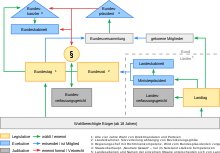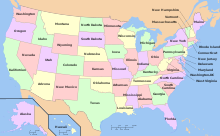Constituent state



As a constituent states (also part of States or sometimes states ) is generally referred to the political entities or units of government quality within a federal state federation ( state ) or a confederation .
General
In contrast to the overall state superordinate to it, the member state in the strict sense does not have any sovereignty under international law , but only a limited, shared sovereignty under state law , for example within the framework of competing legislation . Some international legal sovereignty rights can be preserved the individual states, such as the right to own diplomatic missions in foreign countries to maintain as Bayern in the German Empire was allowed. Its territory and its organs are subject to the “authority” of a higher state structure, the state as a whole; the central power is measured in principle according to the state constitution , in addition there may be agreements with the member states or declarations of the same. This leaves the member states with their own policy fields that are beyond the power of the federal state . Exceptions see the constitutions but often in war case and in other cases of emergency before.
In German constitutional history , “ federal states ” are understood to mean both the partial states of the North German Confederation and the German Reich and the individual member states of the German Confederation .
organization
The constituent state has its own political system , which is usually designed according to the principles of the separation of powers . According to this, there is an executive branch that presides over a government and a legislature which is exercised by a parliament , whereby elements of direct democracy can also exist. Especially in states such as Germany , the Switzerland , the United States or Australia , whose limbs or partial states have (at least partially) existed before the formation of the federal level, which falls to those the exercise of judicial power (judicial) in their area of expertise , which is why they have set up their own courts . In Austria and Belgium, on the other hand, which have only been federalized on the basis of an already existing unitary state, only federal courts exist.
At the level of national legislation , an organ that acts as a representation of the member states (in the narrower sense of the state chamber) or, in the broader sense, an organ that represents the population of the member states (senate model) often takes part.
Relationship with one another and with the state as a whole

Disputes between the member states and between them and the state as a whole are usually decided by courts, in modern state systems by constitutional courts , such as the Federal Constitutional Court in Germany or the Constitutional Court in Austria . If there is a lack of such an institution and a dispute has to be resolved politically, further escalations can result in an armed conflict between the federation and the sub-states, which can even lead to state collapse, as can be seen from the example of the SFR Yugoslavia and its former sub-republics could.
In the political system of the Federal Republic of Germany playing countries play an important role. The federal government (the highest level of the Federal Republic ) cannot abolish the states; their existence is thus guaranteed. Essentially, its limits can only be changed by referendum . The Basic Law separates the state tasks into those that are the federal government and those that are reserved for the states. In addition, there are competencies for which the federal and state governments are jointly responsible. Countries act on the Federal Council in the legislation with the federal government. Furthermore, the states can bring their rights to the Federal Constitutional Court .
Designations
Regarding terminology , it should be noted that during the time of the North German Confederation and the German Empire (1867 to 1918) the individual states constituting the Federation and the Reich were referred to as "federal states". This designation was based on the linguistic usage of the time of the German Confederation (1815–1866), according to which the member states of the federal government were addressed as "federal states", and was independent of whether it was a confederation or a "monarchical-hegemonic federal state" acted. For designated as "federal link" constituent states of the German Reich also the Word was State used before this in the Weimar Constitution of 1919 by country has been replaced; nevertheless, the “federal state” continued to exist in other imperial laws until the 1930s. The term “federal state” can still be found partly in older legal texts , for example in §§ 979, 981, 982 BGB .
In the Swiss Confederation the member states are called cantons , in Austria countries as well as in Germany . In the last two states mentioned, however, the unofficial, synonymous term "federal states" is widespread. The term state is common, for example, in the case of the US states and the partial states of India .
Belgium , a federal state since 1993 , has two types of constituent states, the three regions and the three communities , which are differentiated according to powers. Since the powers of the region Flanders by the Flemish Community are exercised is sometimes talked about that in practice only five constituent states exist. The Belgian system is therefore known as asymmetrical federalism .
In the US , the individual states are called states ( english US states ), in Canada , there are provincial and territorial ( English Proivinces and Territories ). Australia is divided into states, territories and outlying areas .
special cases
In some federal states there are areas that are neither member states nor parts of them, but are directly subordinate to the federal government . These are referred to as federal areas or federal territories , if it is the federal capital , also as federal districts . On the other hand, it is possible that part of a member state does not belong to the state as a whole and thus forms a federal-free area .
Current examples
- the states (also called federal states ) of the Federal Republic of Germany
- the states (also called federal states ) of the Republic of Austria
- the cantons of the Swiss Confederation
- the regions and communities of Belgium
- the states of the United States of America
- the states of India
- the states of Malaysia
- the states of Mexico
- the two entities of Bosnia and Herzegovina
Historical examples
- the countries in the Soviet zone of occupation and the German Democratic Republic (1945–1958)
- the countries of the German Empire during the Weimar Republic (1918–1933)
- the federal states of the German Empire (1871-1918)
- the federal states of the North German Confederation (1867–1871)
See also
Individual evidence
- ^ Heinrich Wilms , Staatsrecht I - State organization law taking into account the federalism reform , Stuttgart 2007, p. 79 .
- ↑ Cf. for example Art. 3 of the constitutions of the North German Confederation of 1867 and of the German Empire of 1871 .
- ↑ See for example Art. VI. or XIII. of the German Federal Act of 1815.
- ^ So Klaus von Beyme (2004) on the description of the Prussian- dominated German Empire, quoted in based on Manfred G. Schmidt , The political system of Germany: Institutions, decision-making and policy fields , 2nd, revised and expanded edition, CH Beck, Munich 2011, ISBN 978-3-406-60390-7 , p. 212 .
- ↑ See for example the ordinance on German citizenship of 1934 , with which the "citizenship in a federal state" anchored in the RuStAG (see Reich and Citizenship Act in the version up to 1934 ) has been eliminated by Section 1 V of February 5, 1934 is.
- ↑ See Christoph Grabenwarter : State Union Constitutional Law , in: Armin von Bogdandy , Jürgen Bast (ed.): European Constitutional Law. Theoretical and dogmatic fundamentals , 2nd, fully updated and extended Edition, Springer-Verlag, Berlin / Heidelberg 2009, ISBN 978-3-540-73809-1 , p. 144.
- ↑ As already Petra Münster (1993), Belgium: A new federal state for Europe , in: EG-Magazin No. 9, pp. 36–37; see. on this Wichard Woyke , The Belgian political system , in: Wolfgang Ismayr (Ed.), The political systems of West Europe , 4th, actual. u. revised Edition, VS Verlag, Wiesbaden 2009, ISBN 978-3-531-16200-3 , pp. 451-482, here pp. 452 f. , 478 ; see. but also Luc Lavrysen, Der belgische Föderalismus anno 2014 , in: Visit of the Belgian Constitutional Court, Proceedings. Federal Constitutional Court, 2015 ( online ) and Claus Hecking , The Belgian political system , VS Verlag, Wiesbaden 2003, ISBN 978-3-8100-3724-4 , in particular pp. 17–24 and 99–115.
- ↑ On the subject cf. Thomas Krumm: A comparison of federal states. An introduction , Springer VS, Wiesbaden 2015, ISBN 978-3-658-04955-3 , in particular the chapter "Belgium: Centrifugal Federalism" (pp. 255–285) and Malte Woydt, Dissociative Federalism (1): Belgo-Föderalismus , in: Ines Härtel (Ed.), Handbuch Föderalismus - Federalism as a democratic legal order and legal culture in Germany, Europe and the world. Volume IV: Federalism in Europe and the World , Springer, Berlin / Heidelberg 2012, § 100 Rn. 7 (p. 749; PDF ). Woydt also emphasizes that Belgium, as an originally unrivaled central state, is gradually relinquishing competences to newly established member states ( centrifugal federalism , marginal no. 3).
